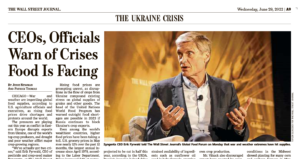The USDA is projecting that the ag trade deficit will shrink in FY2026 even more than previously anticipated. USDA expects the trade deficit to fall from $43.7 billion in FY2025…
Grain Markets at a “Pivot Point,” Global Food Security Could “Take Years” to Return, as War and Weather Hurt Supplies
Bloomberg writers Kim Chipman, Eleanor Song, and Tarso Veloso Ribeiro reported yesterday that, “Global grain markets are at a pivot point, with prices finally starting to ease after a dizzying surge earlier this year.”
The Bloomberg writers explained that, “Russia’s invasion of Ukraine has stifled exports from a region that’s known as the world’s breadbasket. The disruption has sent crop futures to near-record highs, with stockpiles extremely tight. That’s adding to rampant food inflation and raising fears of global grain shortages.
Markets have finally started to calm in recent weeks on optimism that key producers like Australia and the US will reap harvests large enough to help replenish war-pinched reserves.
“But in order to keep food inflation at bay, every bushel of US acre will need to see maximum yield potential. And every bushel of grain will count.”

Chipman, Song, and Ribeiro added that, “There’s also concern over drought this summer for parts of Iowa and Illinois, a US government outlook shows. That could further endanger yields as climate change makes extreme weather events more likely to occur and more severe.
“Already, scorching heat in parts of the Midwest means farmers may have ‘lost the top end of the yields and productivity,’ said Mark Licht, a professor at Iowa State University.
“The market will get a fresh update on acreage Thursday, when the US Department of Agriculture releases its planting survey results along with its quarterly estimates for grain stockpiles.”
Also this week, Reuters writers Karl Plume and Rod Nickel reported that, “Russia’s invasion of Ukraine, a major agricultural exporter, sent prices of wheat, soy and corn to near records earlier this year. Poor weather has also reduced grain harvests in China, India, South America and parts of Europe. Fertilizer shortages meanwhile are cutting yields of many crops around the globe.
“The world has perhaps never seen this level of simultaneous agricultural disruption, according to agriculture executives, industry analysts, farmers and economists interviewed by Reuters, meaning it may take years to return to global food security.”
And Jesse Newman and Patrick Thomas reported in Wednesday’s Wall Street Journal that, “War and weather are imperiling global food supplies, according to U.S. agriculture officials and executives, as rising food prices drive shortages and protests around the world.

“The pressures are playing out this year as conflict in Eastern Europe disrupts exports from Ukraine, one of the world’s top crop producers, and drought and poor weather afflict major crop-growing regions.”
Reuters writer Maximilian Heath reported yesterday that, “Argentina had a record 2021/22 wheat harvest of 22.4 million tonnes, so global grain markets had hoped the country could help fill the shortfall of grain lost after Russia’s invasion of Ukraine. The conflict between the two major wheat exporters has sent prices soaring.
“But now, both of Argentina’s main grains exchanges, Buenos Aires and Rosario, have cut wheat planting forecasts and warned of more cuts if the weather does not improve.”
Nonetheless, a separate Reuters News article yesterday reported that, “The Russia-focused Sovecon agriculture consultancy said on Wednesday it had raised its forecast for Russia’s July-June wheat exports by 300,000 tonnes to a new record high of 42.6 million tonnes.”
Also yesterday, Wall Street Journal writers Jon Emont and Suryatapa Bhattacharya reported that, “Russia’s invasion of Ukraine has driven up food prices around the world, but the situation is less grim in Asia. Thank rice.
“Following successive bumper crops, rice has emerged as a rare food commodity that has generally been cheaper this year than it was last year. That’s great news for the billions of people who live across the swath of Asia where the grain is a popular staple, from India to Thailand, Vietnam and Japan. The region encompassing South, Southeast and East Asia produces and consumes more than 80% of the world’s rice, according to data from the U.S. Department of Agriculture.”
Elsewhere, New York Times writer Michael D. Shear reported this week that, “The United States and its Group of 7 allies on Tuesday pledged to spend $4.5 billion this year to help ensure food security around the globe, seeking to counter global food shortages caused by Russia’s invasion of Ukraine.
“The G7 leaders said in a statement that the money would be used to ease what they called a ‘multidimensional crisis‘ that has left as many as 323 million people around the globe at high risk of food shortages, a record.”
And Reuters News reported yesterday that, “Russia’s top diplomat told the secretary general of the United Nations on Wednesday that the country was ready to coordinate efforts to reduce the threat of a global food crisis, the Russian foreign ministry said.”
Meanwhile, Bloomberg writers Megan Durisin and Abdel Latif Wahb reported today that, “Egypt booked the most wheat in a tender in at least a decade, taking advantage of a recent price slump to bolster stockpiles as Russia’s invasion of Ukraine disrupts global supplies.
“The country’s state-run buyer bought 815,000 tons on Wednesday, the largest single purchase since at least 2012, data compiled by Bloomberg show.”





